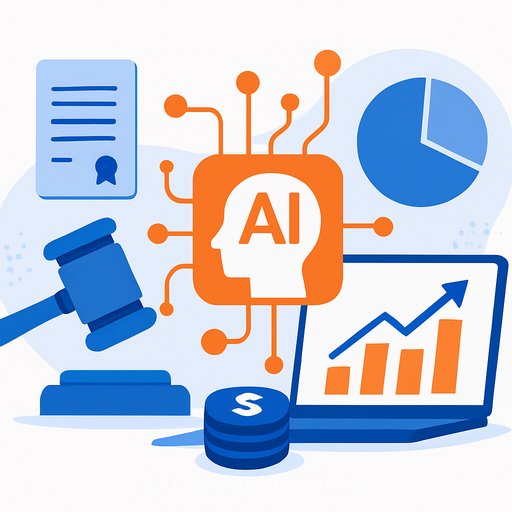Legal AI Impact: Stop Chasing Use Cases. Build Fluency, Workflows, and Strategy
Generative AI went mainstream, and legal teams moved fast. Tools were bought, pilots launched, and training started. Yet many departments still can't point to meaningful cost savings or measurable impact. A recent MIT finding suggests up to 95% of generative AI pilots deliver no clear ROI-so the problem isn't interest, it's execution.
The Use Case Trap
Legal teams are hunting for a "killer application" to prove value. That search is a distraction. Inside the same department, adoption is uneven-one attorney is testing agent workflows while another avoids AI entirely. No single use case fixes that gap.
Real impact comes from building fluency and embedding AI into how work moves. Share use cases to show what's possible, but pair them with training, governance, and redesigned workflows. That's how you move from scattered wins to department-level outcomes.
Two Dimensions That Drive Results
1) Scaling Efficiency
AI usage is already happening. Many employees use AI even without sanctioned access. Personal gains-faster summaries, quicker clause searches-are helpful but don't change the budget. To affect the bottom line, efficiency must be systemic.
- Integrate with business context: Move beyond standalone chatbots. Plug AI into intake, triage, matter management, and document systems.
- Redesign workflows: Let AI handle intake, initial analysis, and issue-spotting before a lawyer touches it.
- Automate routine steps: Use agents to draft fallback language, propose negotiation positions, and generate correspondence for review.
- Make outputs verifiable: Define quality criteria, add human checks where risk is high, and log decisions for auditability. Consider frameworks like the NIST AI Risk Management Framework.
When AI is embedded at this level, contracts move faster, large reviews scale without more headcount, and cycle times drop. That's where efficiency shows up on financials.
2) Expanding Strategy
Efficiency alone is fragile. Verification overhead can wipe out time savings, and shaving minutes off emails won't change how the business sees legal. The bigger win is capability expansion: use AI as a thought partner on higher-value work.
- Scenario testing: Have AI play the counterparty to stress-test arguments and positions.
- Strategic brainstorming: Generate alternative deal structures, risk mitigations, and playbooks.
- Context synthesis: Combine regulatory updates, precedents, and internal policies into options and recommendations.
This isn't about ceding judgment. It's about pressure-testing ideas and widening the option set. One stronger argument, one avoided dispute, or one creative deal structure can pay for your program many times over.
Make It Real: A 90-Day Legal AI Plan
- Baseline and goals: Define 3-5 metrics (cycle time, review throughput, error rate, outside counsel spend, intake backlog). Set targets.
- Access and guardrails: Provide approved tools, privilege and confidentiality guidelines, and data handling rules. Limit shadow AI.
- Pick two workflows: Choose one high-volume (e.g., NDA intake) and one strategic (e.g., negotiation prep). Map current vs. future state with AI in the loop.
- Proof and QA: Establish acceptance criteria, spot-check outputs, and maintain a feedback log. Build a small red team for edge cases.
- Train by role: Short, job-specific sessions for attorneys, ops, and admins. Provide templates, prompts, and checklists.
- Integrate and automate: Connect AI to document repositories, clause libraries, and matter systems. Add light automation for handoffs and notifications.
- Measure weekly: Track usage, output quality, and time saved. Publish a simple dashboard; socialize quick wins.
- Iterate: Fix the bottlenecks you find-data access, model quality, or review burden-before scaling to a third workflow.
Metrics That Matter
- Efficiency: Turnaround time by matter type, documents reviewed per attorney per week, percentage of "first-draft by AI," outside counsel hours avoided, cost per matter.
- Quality and trust: Error rate by category, rework rate, escalation rate, adherence to playbooks.
- Strategic impact: Disputes avoided, improved negotiation outcomes, revenue acceleration from faster deal cycles, decision quality as rated by business partners.
Common Failure Patterns
- Tool without workflow: A chatbot with no integration into intake or review won't scale value.
- Siloed wins: One power user saves hours; everyone else keeps old habits.
- Verification tax: Saving 15 minutes and spending 30 to check it-net loss.
- No data access: AI can't find clauses or prior positions; quality suffers.
- Prompt theater: Clever prompts won't fix weak processes or missing governance.
- No change management: Policies, training, and accountability are afterthoughts.
Build Fluency Across the Department
Adoption follows fluency. Give every attorney safe access, role-based training, and clear examples of where AI helps and where it doesn't. Standardize prompts and review checklists. Publish playbooks and keep them current.
If you need structured upskilling for nontechnical teams, consider curated programs that focus on practical workflows, policy, and measurement. For options, see AI courses by job function.
The Bottom Line
Stop chasing the perfect use case. Focus on the system: fluency, embedded workflows, trustworthy outputs, and strategic use. Efficiency scales when it's built into delivery; strategy compounds when AI sharpens judgment.
Do both, measure both, and the business will feel the difference-faster cycles, stronger outcomes, and a legal team that operates with more reach than its headcount suggests.
Your membership also unlocks:






